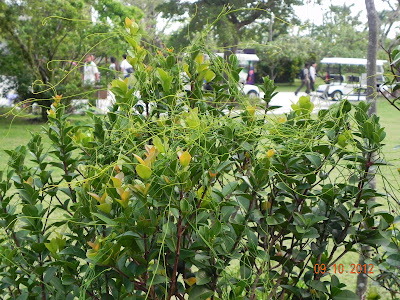Cuscuta, which is commonly known as Dodder, is a parasitic plant from the Family Convolvulaceae. Yes, it is hard to imagine that this leafless vine-like looking plant belongs to the same family as the Morning Glory.
Like many other parasitic plants, the Dodder has haustoria that attaches itself onto the branches of its host plants and draws nutrients from it. In fact, this plant has minute scales as leaves and an interesting life-cycle, which includes flowering and seed setting, like any other angiosperm.
I first saw this parasitic plant in the late 90s growing on and smothering a bed of dwarf Duranta shrubs I planted in front of the Lavender MRT station. I have also seen it growing on the Sphagneticola trilobata (Synonym: Wedelia trilobata, Complaya trilobata, Thelechitonia trilobata, Silphium trilobatum; Family: Asteraceae / Compositae). The only way to get rid of this parasite is not to pull it off the host plant because its remaining haustoria on the host plant is more than capable of regenerating the parasitic plant, but rather to prune the host plant back significantly to remove any remnants of the parasite. In extreme cases, the entire host plant may have to be removed and discarded and the plant replaced with a non-host species.
